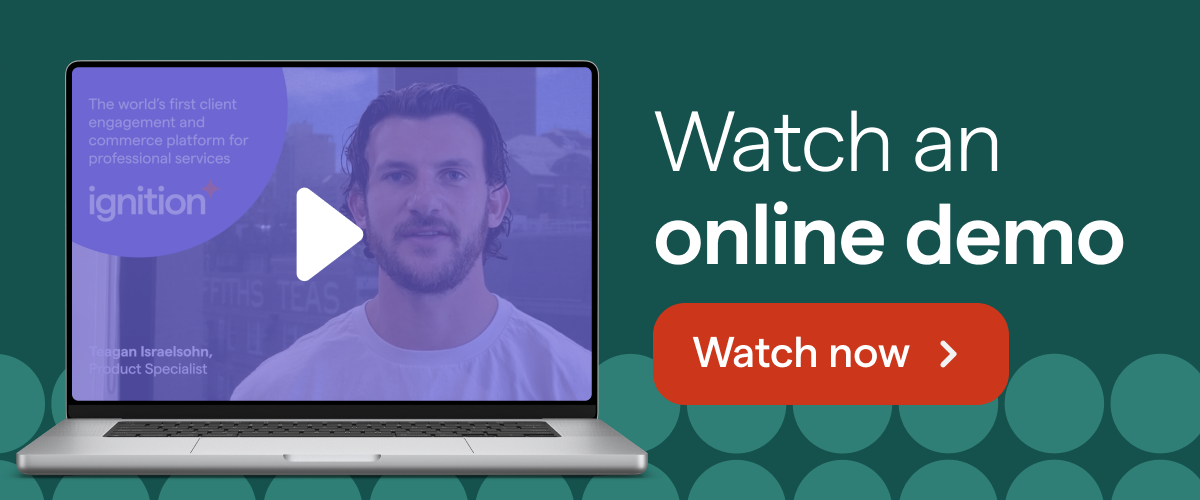Client onboarding guide: 8 steps for happier clients and improved retention

For client-orientated businesses – such as accounting firms, marketing companies, and other professional services businesses – client onboarding isn't just a polite formality. It's an essential business strategy and a vital building block for lasting client relationships.
A winning onboarding process leads to happier clients who stay with your business for longer. So, it's essential to create a process that impresses your clients and sets the stage for future interactions.
In this guide, we delve into everything you need to know about client onboarding and share actionable advice, so you can develop a successful process and improve your existing one. Let’s dive in.What is client onboarding?
Client onboarding is the process of welcoming new clients into your business. It's your opportunity to begin building a solid relationship, get the client up to speed, address any queries, and outline the strategy going forward.
The importance of client onboarding
Client onboarding isn't just a nice add-on – it's a crucial business strategy. When done effectively, it leads to:
Greater efficiency: Onboarding helps you just as much as it helps your clients. It gives you need-to-know information at your fingertips, leaving you in the best possible position to begin working for a client. As a result, this helps you increase efficiency and avoid bottlenecks further down the line.
Mastering out-of-scope work: The onboarding process can help you effectively manage out-of-scope work, also known as 'scope creep'. A comprehensive process includes clearly defining the project parameters, outlining responsibilities, and detailing deliverables. This establishes a mutual understanding between you and your client about how out-of-scope requests will be handled.
Happier clients: Clients want to work with practices that know what they're doing, have a clear plan of action, and who are invested in building strong relationships. When you demonstrate this, your customers will be happier and your Net Promoter Score (NPS) will increase.
More clients: By delighting your customers from the get-go, you're far more likely to build strong relationships, upsell existing customers in the future, and gain referrals based on your excellent work and customer relationships. According to the Harvard Business Review, 84% of B2B decision-makers begin their buying process with a referral.
Compliance: A well-thought-out, highly repeatable onboarding process helps you to ensure that compliance is baked into everything you do.
Not all onboarding processes are created equal though. To enjoy the benefits above, you need to systematize and optimize your onboarding process so you can work efficiently and build effective relationships.
An example of a client onboarding process
It's crucial that your practice has a defined, highly repeatable client onboarding process in place. In doing so, you'll kick off your relationships on the right foot, gain all the information you need to wow your customers, and show your professionalism.
Every firm has its own unique onboarding process that depends on a variety of factors, such as internal capabilities, the services it offers, and its clients.
That said, the following are a few general guidelines and an example of a client onboarding workflow you can incorporate into your own firm.
1. Get your contract or engagement letter signed by your client
First things first. You need to receive a signed contract or engagement letter from your new client. Don't begin any work until you have a signed copy.
In other words, until there's a legally binding agreement between both parties, don’t start your client onboarding process. Without a signed contract or engagement letter, there’s no clear understanding of the terms, responsibilities, and obligations of both the service provider and the client.
You can make this step easier by using a solution such as Ignition, which is an all-in-one platform that empowers businesses to get paid faster and run smarter. Ignition automates and optimizes proposals, client agreements, and billing and payment collection to ensure your engagements get off on the right foot, and to put an end to late payments, unbilled work and mundane repetitive admin.
You can use Ignitions's proposal templates and engagement letters to outline your services and terms, and have clients sign these online.

If you require payment before you start working, Ignition makes this step easier, too. You can collect payment details upfront in your proposal, and make paying and getting paid something no one has to worry about ever again. You can also make it convenient for clients to pay automatically via credit card or automated clearing house (ACH).
If you're not using Ignition, you can piece everything together manually using the following four steps:
Create your proposal and send it to your client.
Create the contract and send it over.
Send your invoice (using your preferred invoicing software).
Follow up with your client to collect the signed documents and any payment.
Just bear in mind that doing this manually is time-consuming, inefficient, and opens up room for additional admin work, plus the potential for human error.
Once you receive confirmation the client has paid, signed the proposal, and signed the contract, you can then move to the next step.

2. Ask your client to complete a client intake form or onboarding questionnaire
Before you begin work, you’ll need them to provide certain information. That's where the client intake form or onboarding questionnaire comes in.
These forms provide valuable client details that you can use to inform the onboarding process. When you implement them correctly, intake questionnaires help you better understand clients, and they can set the stage for a successful partnership.
Your intake form content will vary depending on your business, services, and clients. Broadly speaking though, standard intake forms contain questions about the following:
The client's contact details.
Information about their business.
Details about their needs and challenges.
The services they require.
The client's current processes, workflows, and communication preferences.
Designing your client intake form requires some thought; you need to think about the questions you'll ask, as well as the right fields to include in your questionnaire. You also need to format the document properly and make sure it's on-brand.
Make this step more manageable by customizing templates for your specific customer onboarding process.
For best results, use a digital form builder such as Typeform to create your questionnaire. Unlike PDFs or paper-based forms, Typeform provides a visually appealing and interactive user interface. It allows you to create engaging forms with customizable designs, dynamic questions, and multimedia elements. This is an example of a client intake form or onboarding questionnaire using Typeform.
If you were to automate the onboarding process to improve the client experience, free up your time, and help prevent errors, you could connect Typeform to Ignition, using Zapier. This ‘Zap’ automatically creates new clients in Ignition whenever customers fill out a form through Typeform.
By eliminating the need to re-enter client details from one app to the next, you can simplify your sales process and client onboarding workflows, and get clients up and running faster.

3. Assign the client and get the project rolling
The next step in the client onboarding process is matching your new client with the right team member. Once you have collected all the required information, you can assign the client to the team that will look after the account.
Pro tip: Try to make sure the lead point of contact has some commonalities with the client – this will help them build a strong working relationship.
Have a meeting with the team who will be taking on the client and debrief them with the following information:
Project summary.
The factors that would make this a successful project for the client.
The timeline.
Any research about the client that’s applicable.
What the team needs from the client to complete the project.
It's also important to share all previous communications with your team. It can be frustrating for the client to repeat themselves to different members of your firm, so it pays to keep your team in the loop. Ideally, all of this information will be stored in your customer relationship management (CRM) or client management software.
Once the meeting is over, launch the project in your preferred project management system or workflow software: Basecamp, Asana, Workflow Max or others. If you usually invite clients to collaborate on the project, now's the time to do it.
4. Have a client kick-off meeting
By this point, the client onboarding process is well underway.
Everybody (including the client) should be excited and ready to get this project off the ground. Client kick-off meetings are a great way to build trust and rapport with both teams and set the tone for the relationship.
These are some of the things to go over in the client kick-off meeting:
Make the necessary introductions between the client and the team.
Review the client’s intake form.
Discuss the client's business goals.
Cover major deliverables and responsibilities (including a detailed timeline of action).
Outline items that are out of scope.
Talk about the next steps.
Conduct a Q&A if necessary.
By the end of the meeting, the aim is to have built a strong rapport between the client and your team, answered any of the client's questions, and outlined how the project would proceed.
As for where these meetings should take place, it depends on you and the client. If you all work in the vicinity, conducting an in-person meeting may be beneficial. On the other hand, Zoom, Google Meet, or Teams would be the better way to go if you're working remotely.
If you're meeting through digital channels, strive to keep your systems tightly integrated to create a seamless client onboarding process. For instance, when you integrate Calendly and Zoom, you don't have to manually set up a Zoom meeting when someone schedules a call. The integration creates a Zoom meeting for you and automatically sends it to your client, so all you have to do is show up.
Similarly, you can use Typeform, Calendly, and Ignition to automate your client onboarding process. Once you've integrated Typeform and Ignition through Zapier (as discussed above), you can use this Zap to send a Typeform questionnaire from a calendar invite.
This means clients automatically receive the intake form when they book a call with you, so you can make sure they complete it before your kick-off meeting.
5. Determine what success looks like
Establish key performance indicators (KPIs) or success metrics to track the impact of your services. Based on what you've gathered through the client's intake form and kick-off meeting, ask yourself: What does success look like?
From there, come up with measurable goals that will help you track your progress and performance. These metrics will obviously vary from one provider to the next. If you provide tax or financial services, success could mean lowering your clients' tax bills or helping them get through an audit unscathed.
On the other hand, if you provide digital marketing services such as social media management, your success metrics would likely be tied to engagement, follower counts, shares, and more. Meanwhile, those offering digital advertising services can measure traffic, ad spend, ROI, and so on.
The bottom line: establishing specific and measurable KPIs or success metrics tailored to your services is crucial to effectively track and evaluate the impact of your efforts and make sure you are aligned with your client's goals and expectations.

6. Provide training or knowledge if necessary
Say you're a digital marketing consultancy firm and your services include helping clients set up their reporting capabilities. In this instance, it would be helpful to train your clients on the necessary analytics software, so they can extract the information they need.
Or, suppose you're a bookkeeping firm helping your client transition from using manual processes to a digital solution such as QuickBooks. In this scenario, you can set up training sessions to make sure your clients know how to navigate the software.
Of course, client training isn’t always about teaching them how to use software. In some cases, this part of the onboarding process can be as simple as explaining how to best get in touch with you.
If you’re launching advisory services, it could also encompass educating them about cash flow management, employee compensation, and building a sustainable business, which can often cause sleepless nights for clients. Whatever the case, it's best to make knowledge transfer a key part of your client onboarding process.
By keeping clients informed about your processes, software, and broader industry trends, you can position yourself as a valuable partner.
7. Have a check-up meeting and schedule future check-in calls with your clients
At this stage of the client onboarding process, you've likely started delivering your services and implementing the projects you agreed on.
To ensure things go smoothly, schedule a check-in call 30 days after beginning to work with a client. This is your opportunity to make sure that nobody has dropped the ball during the onboarding process and to check that everything is happening as it should from their end.
The first 90 days are important for building a great first impression. If you can catch mistakes early and remedy them going forward, you'll be able to retain more clients and build better relationships.
This check-up call is also a great time to gently nudge clients for more information or documents that they may still need to send over. An email might get lost in their inbox or temporarily ignored. You're far more likely to elicit a response by raising it on a call.

8. Gather feedback to refine and improve the client onboarding process
Your onboarding process is a key part of your business that you’ll want to continually evolve and improve upon. Collecting quantitative and qualitative data helps you enhance your processes and make informed decisions based on facts, not feelings.
You can also use a tool such as CheckMarket to collect an NPS survey from your client. This helps you gather actionable insights into your onboarding process, to help improve it and the overall client experience.
Questions you could ask include:
How would you rate your overall satisfaction with the onboarding process?
How clear and timely was our communication during the onboarding process? Did we provide all the information you needed?
How would you rate the efficiency of our onboarding process? Were tasks completed in a timely manner?
How easy was it to understand and complete the tasks required for the onboarding process?
How would you rate the support you received during the onboarding process? Did you feel your questions or concerns were addressed effectively?
Did our onboarding process meet, exceed, or fall short of your expectations?
How likely are you to recommend our services based on your onboarding experience? (This is the typical NPS question).
Do you have any suggestions for how we could improve our onboarding process?
Client onboarding checklist (12-point sample)
Finally, a checklist can help you and your team can get clients up and running as smoothly (and consistently) as possible.
Checklists might seem basic, but these can be a game-changer, because these systematize your onboarding process and help to reduce human error. A checklist also gives your team a clear list of tasks to work through.
By laying out the precise end-to-end workflow, you can make sure that every step is logical and contributes to the goal: client satisfaction.
To help you with this step, here’s an easy-to-follow checklist based on the above information. Go through it, and feel free to adapt and customize the list to fit your specific client onboarding workflow.
Client onboarding checklist
- Use a professional services platform such as Ignition to automate the process. Create and send proposals and engagement letters in minutes with custom templates you can use time and again.
- Make sure you receive payment information from the new client before proceeding. With Ignition, you can collect payment details upfront and automate payment collection from the moment a client signs your proposal. When the invoice is due, Ignition automatically takes the payment, so you and your client don’t have to lift a finger.
- Design a comprehensive intake form using a digital form builder such as Typeform. Use this example of a client intake form for guidance.
- Match your new client with the appropriate team members.
- Hold a meeting with these members of your team to share project details, goals, timelines, and client requirements.
- Share previous communications and relevant information with the team through a CRM or client management software.
- Launch the project in a PMS or workflow software.
- Introduce the client to the team members.
- Review the client intake form or client onboarding questionnaire and discuss the client's business goals.
- Define major deliverables, responsibilities, and timelines.
- Clarify what is included in the scope of work.
- Discuss the next steps and address any client questions or concerns.
- Conduct the meeting in person or through video conferencing tools such as Zoom, Google Meet, or Teams.
- Based on the information you gather from the intake form and kick-off meeting, define KPIs or success metrics.
- Tailor the metrics to the specific services provided (for example, tax services, digital marketing services) and the client's objectives.
- Set measurable goals to track progress and performance.
- If applicable, offer training sessions about new systems, tools, or processes.
- Make sure clients understand how to use software or best practices for communication, feedback, or project updates.
- Educate clients about industry trends, market insights, or emerging technologies that may impact their business.
- For advisory services, you may need to work with them to help them understand what needs to happen to improve parts of their business, such as their cash flow management, and employee compensation.
- If applicable, offer training sessions about new systems, tools, or processes.Schedule a check-up call 30 days after the project starts to make sure everything is running smoothly.
- Address any issues, gather missing information, and assess progress.
- Schedule future check-in meetings to review performance and ensure alignment with goals and metrics.
- Ask specific questions to identify areas of your onboarding process that are working well and/or could be improved.
- Consider using tools such as CheckMarket to collect NPS surveys.
- Continuously improve your onboarding process based on feedback and data collected.
Your client onboarding process should be adaptable to your specific business needs and client requirements. Regularly review and update the checklist to ensure a smooth and efficient onboarding experience for your team and clients.
Keep an eye out for ways to automate and streamline the steps in your client onboarding, so you can free up your valuable time! Identify areas with manual work or double entry, then address them using apps and integrations, such as Ignition.
Over to you
Ready to simplify and onboard your client onboarding process? Ignition automates and optimizes proposals, client agreements, billing, payment collection and workflows – all in one platform – freeing up your time so you can focus on successful onboarding and serving more clients. Watch a demo to find out more.
